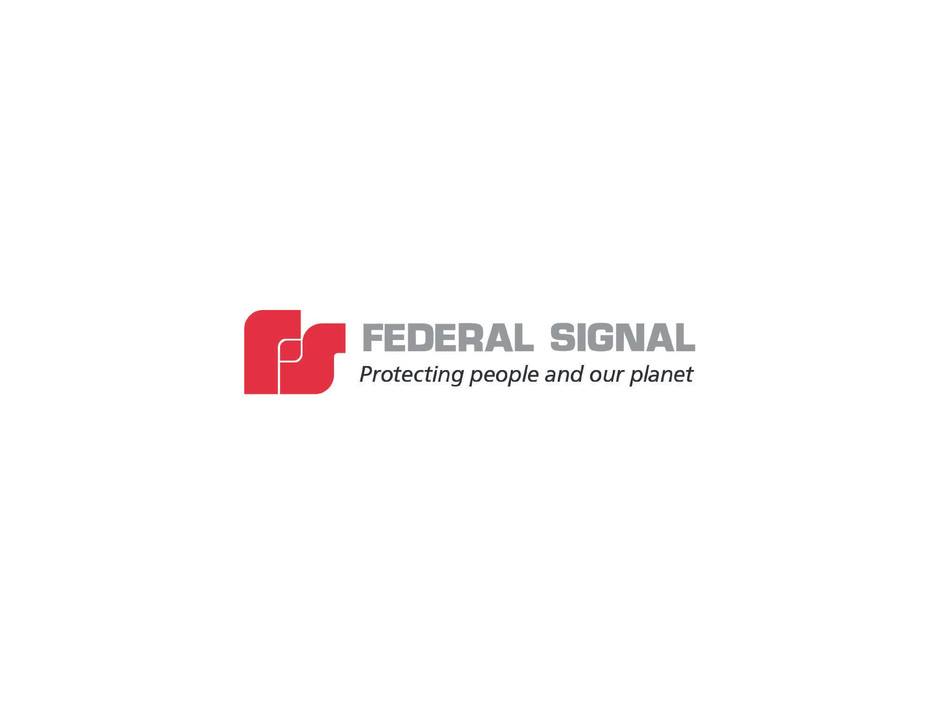Attached files
| file | filename |
|---|---|
| 8-K - FORM 8-K - FEDERAL SIGNAL CORP /DE/ | fss20155118-kinvestorprese.htm |
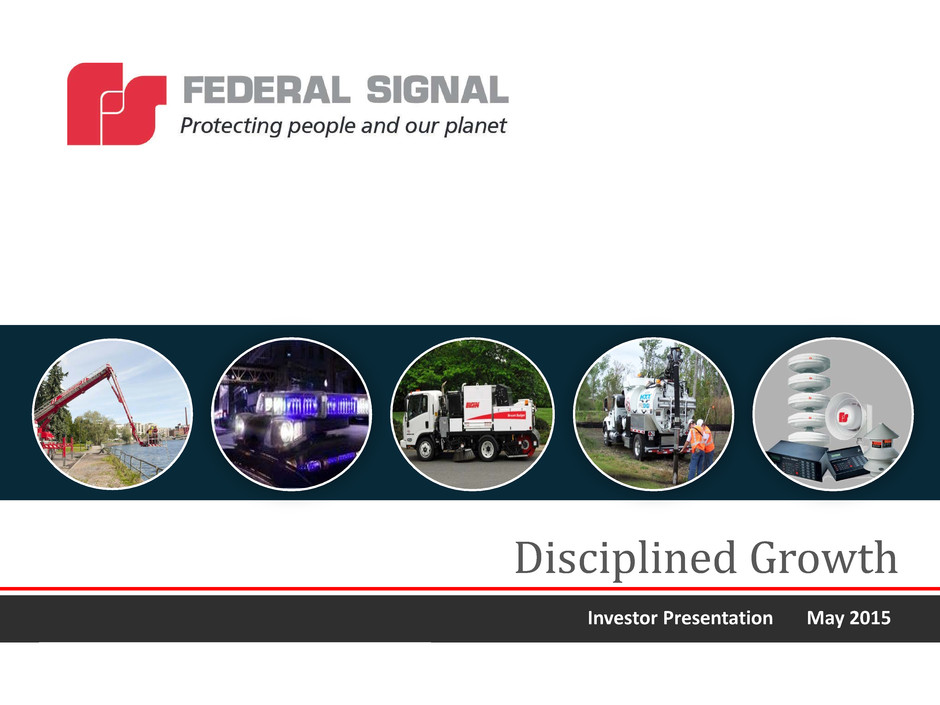
Disciplined Growth Investor Presentation May 2015

Safe Harbor Statement 2 This presentation contains unaudited financial information and forward-looking statements. Statements that are not historical are forward-looking statements and may contain words such as “may”, “will”, “believe”, “expect”, “anticipate”, “intend”, “plan”, “project”, “estimate”, and “objective” or similar terminology, concerning the company’s future financial performance, business strategy, plans, goals and objectives. These expressions are intended to identify forward-looking statements within the meaning of the Private Securities Litigation Reform Act of 1995. Forward-looking statements include information concerning the Company’s possible or assumed future performance or results of operations and are not guarantees. While these statements are based on assumptions and judgments that management has made in light of industry experience as well as perceptions of historical trends, current conditions, expected future developments and other factors believed to be appropriate under the circumstances, they are subject to risks, uncertainties and other factors that may cause the Company’s actual results, performance or achievements to be materially different. Such risks and uncertainties include, but are not limited to, economic conditions, product and price competition, supplier and raw material prices, foreign currency exchange rate changes, interest rate changes, increased legal expenses and litigation results, legal and regulatory developments and other risks and uncertainties described under Item 1A, Risk Factors, in the Company’s Annual Report on Form 10-K and in other filings with the Securities and Exchange Commission. Such forward-looking statements are made as of the date hereof and we undertake no obligation to update these forward-looking statements regardless of new developments or otherwise. This presentation also contains certain measures that are not in accordance with U.S. generally accepted accounting principles (“GAAP”). The non-GAAP financial information presented herein should be considered supplemental to, and not a substitute for, or superior to, financial measures calculated in accordance with GAAP. The Company has provided this supplemental information to investors, analysts, and other interested parties to enable them to perform additional analyses of operating results, to illustrate the results of operations giving effect to the non-GAAP adjustments shown in the reconciliations, and to provide an additional measure of performance which management considers in operating the business. A reconciliation of these items to the most comparable GAAP measures is provided in our filings with the SEC and in the Appendix to this presentation.

Agenda • Management • Company at a glance • Investment case • Performance trends • Segments and products • Growth strategy • Corporate focus, goals and initiatives • Financial results and outlook 3

Experienced Management Team Dennis Martin, President and Chief Executive Officer President and Chief Executive Officer since October 2010 Previously served as Chairman, President and CEO of General Binding Corporation 35+ years operational and leadership experience, primarily at Illinois Tool Works and Ingersoll-Rand 4 Brian Cooper, Chief Financial Officer Appointed Chief Financial Officer May 28, 2013 Chief Financial Officer of Westell Technologies, Inc. from 2009-2013 Previously with Fellowes, Inc. (CFO), United Stationers, Borg-Warner Security and Amoco Strong treasury, financial, M&A and strategic background Jennifer Sherman, Chief Operating Officer Appointed Chief Operating Officer April 29, 2014 Previously Chief Administrative Officer, Secretary and General Counsel, with operating responsibilities for the Company’s Safety and Security Systems Group Joined Federal Signal in 1994 as Corporate Counsel
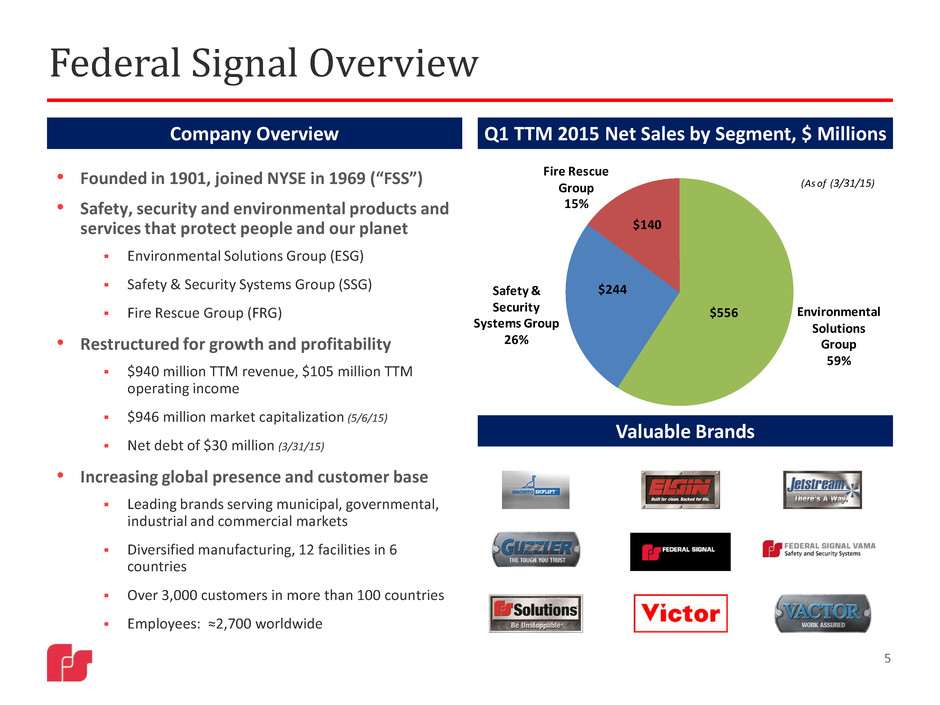
Federal Signal Overview • Founded in 1901, joined NYSE in 1969 (“FSS”) • Safety, security and environmental products and services that protect people and our planet Environmental Solutions Group (ESG) Safety & Security Systems Group (SSG) Fire Rescue Group (FRG) • Restructured for growth and profitability $940 million TTM revenue, $105 million TTM operating income $946 million market capitalization (5/6/15) Net debt of $30 million (3/31/15) • Increasing global presence and customer base Leading brands serving municipal, governmental, industrial and commercial markets Diversified manufacturing, 12 facilities in 6 countries Over 3,000 customers in more than 100 countries Employees: ≈2,700 worldwide 5 Company Overview Q1 TTM 2015 Net Sales by Segment, $ Millions Valuable Brands $556 $244 $140 Environmental Solutions Group 59% Safety & Security Systems Group 26% Fire Rescue Group 15% (As of (3/31/15)

Investment Case • Leading positions in niche governmental and industrial markets • Valuable brands, high quality products, well-established distribution • Flexible manufacturing capacity to leverage profits • Favorable market dynamics Improving municipal spend and top North American dealer network Growing higher-margin industrial markets Security solutions addressing man-made and natural disasters • Solid execution, results and outlook Company culture steadfastly focused on “80/20” and continuous improvement Management depth in sales, marketing, engineering and operations Organic and inorganic opportunities to grow shareholder value Strong balance sheet, profitability and free cash flow 6
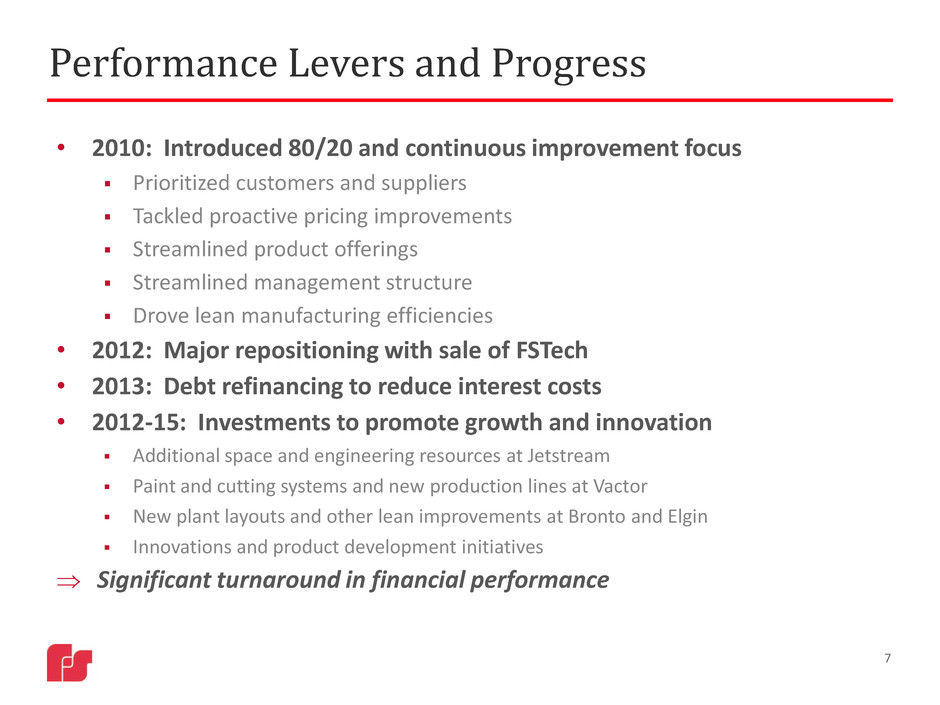
Performance Levers and Progress • 2010: Introduced 80/20 and continuous improvement focus Prioritized customers and suppliers Tackled proactive pricing improvements Streamlined product offerings Streamlined management structure Drove lean manufacturing efficiencies • 2012: Major repositioning with sale of FSTech • 2013: Debt refinancing to reduce interest costs • 2012-15: Investments to promote growth and innovation Additional space and engineering resources at Jetstream Paint and cutting systems and new production lines at Vactor New plant layouts and other lean improvements at Bronto and Elgin Innovations and product development initiatives ⇒ Significant turnaround in financial performance 7
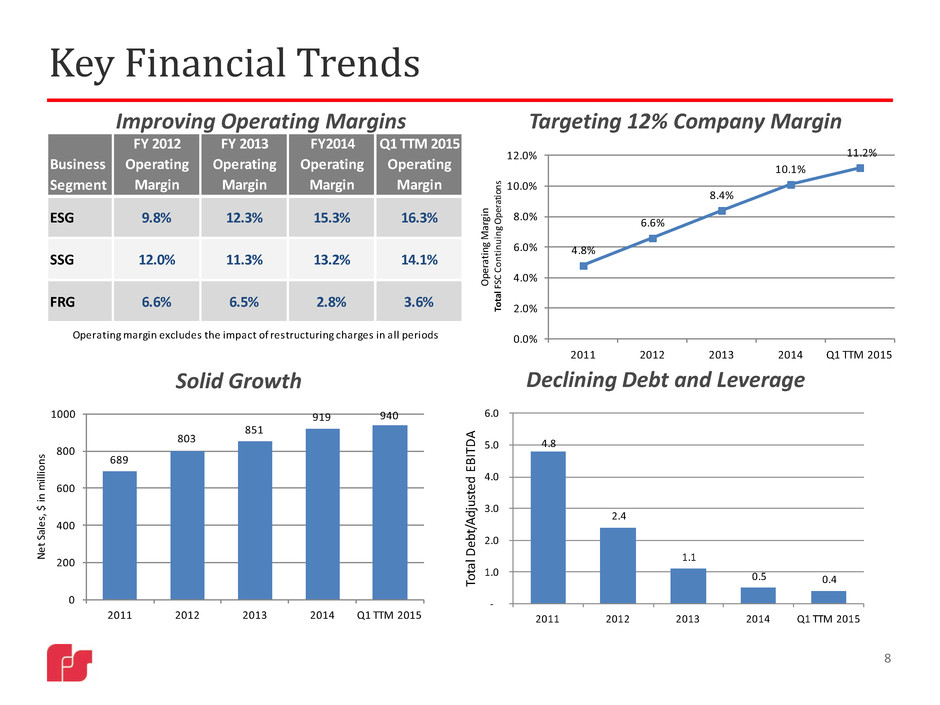
Key Financial Trends 8 Improving Operating Margins Solid Growth Targeting 12% Company Margin Declining Debt and Leverage 4.8% 6.6% 8.4% 10.1% 11.2% 0.0% 2.0% 4.0% 6.0% 8.0% 10.0% 12.0% 2011 2012 2013 2014 Q1 TTM 2015 O pe ra ti ng M ar gi n To ta l F SC C on ti nu in g O pe ra tio ns 689 803 851 919 940 0 200 400 600 800 1000 2011 2012 2013 2014 Q1 TTM 2015 N et S al es , $ in m ill io ns 4.8 2.4 1.1 0.5 0.4 - 1.0 2.0 3.0 4.0 5.0 6.0 2011 2012 2013 2014 Q1 TTM 2015 To ta l D eb t/ A dj us te d EB IT D A Business Segment FY 2012 Operating Margin FY 2013 Operating Margin FY2014 Operating Margin Q1 TTM 2015 Operating Margin ESG 9.8% 12.3% 15.3% 16.3% SSG 12.0% 11.3% 13.2% 14.1% FRG 6.6% 6.5% 2.8% 3.6% Operating margin excludes the impact of restructuring charges in all periods

9 Federal Signal Segments Environmental Solutions (ESG) Products Geographic Mix Q1 TTM 2015 Revenue Elgin street sweepers Vactor truck-mounted sewer cleaners, hydro-excavators, and industrial vacuum trucks Jetstream waterblasters FS Depot and FS Solutions – parts and service deliveries and rental centers $556M (59% of sales) $244M (26% of sales) $140M (15% of sales) Fire Rescue (FRG) Bronto Skylift high-reach aerial lift access platforms for fire rescue and wind turbine maintenance, utilities and other industrial applications Safety and Security Systems (SSG) Vehicle lights and sirens (U.S. and Vama) Indoor and outdoor mass warning and notification systems (Industrial Systems and Alerting & Notification Systems) Victor mining and electrical safety equipment Non-US 20% ≈30-50% U.S. Range, avg. ≈30% U.S. ≈50% Globally Representative Market Share Non-U.S. 18% U.S. 82% Non-U.S. 41% U.S. 59% Non-U.S. 87% U.S. 13%
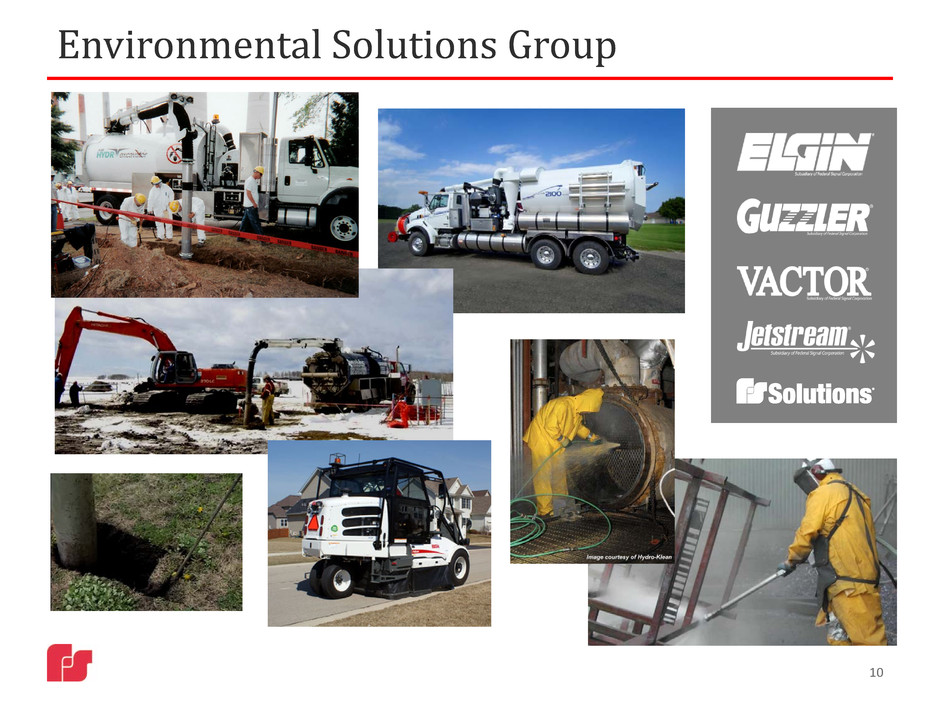
Environmental Solutions Group 10
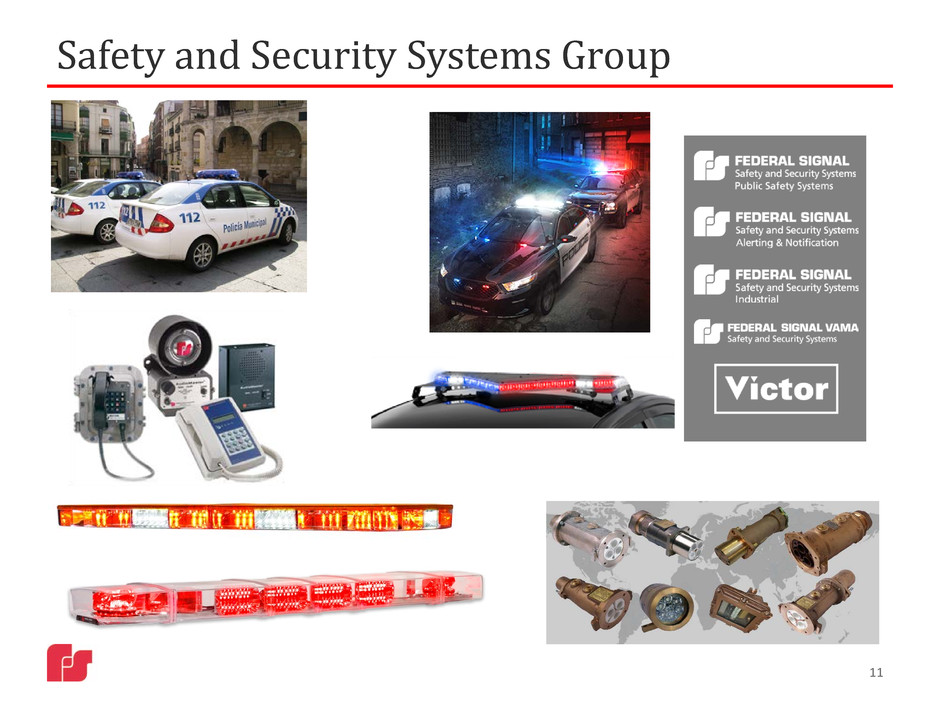
Safety and Security Systems Group 11

Safety and Security Global Systems 12 SmartMsg Enabled Systems Enterprise Integrated Command Solution Sensors/Detectors Cameras Networked PAGASYS Rack Control Modules/Nodes Control Modules/Nodes Control Modules/Nodes

Fire Rescue Group 13

Growth Strategy 14 Geographic Expansion • Jetstream and Industrial Systems in the Asia Pacific and Middle East • Export markets from U.S. • Bronto in North America New Markets for Existing Products • Waterblasting • Hydro-excavation • Security systems New Product Development and Acquisitions • Innovation program • Leverage use of established platforms
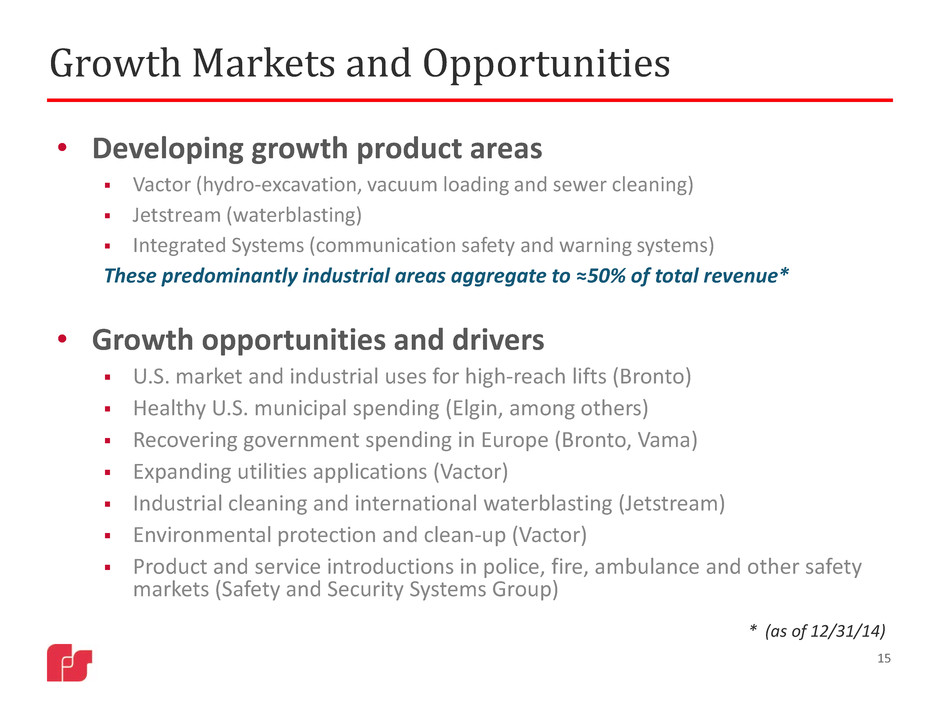
Growth Markets and Opportunities • Developing growth product areas Vactor (hydro-excavation, vacuum loading and sewer cleaning) Jetstream (waterblasting) Integrated Systems (communication safety and warning systems) These predominantly industrial areas aggregate to ≈50% of total revenue* • Growth opportunities and drivers U.S. market and industrial uses for high-reach lifts (Bronto) Healthy U.S. municipal spending (Elgin, among others) Recovering government spending in Europe (Bronto, Vama) Expanding utilities applications (Vactor) Industrial cleaning and international waterblasting (Jetstream) Environmental protection and clean-up (Vactor) Product and service introductions in police, fire, ambulance and other safety markets (Safety and Security Systems Group) 15 * (as of 12/31/14)

Focus and Long-Term Goals 16 Create Disciplined Growth Organic and Acquisitions Diversify Customer Base Leverage Invested Capital Improve Manufacturing Efficiencies and Costs Operating margin targets Grow revenue faster than GDP, Grow EPS at an average % rate in low to mid teens Consolidated ‒ 12% ESG ‒ 13-16% SSG ‒ 14-16% FRG ‒ 10-12% Increase industrial revenue share Continually improve ROIC Grow Shareholder Value
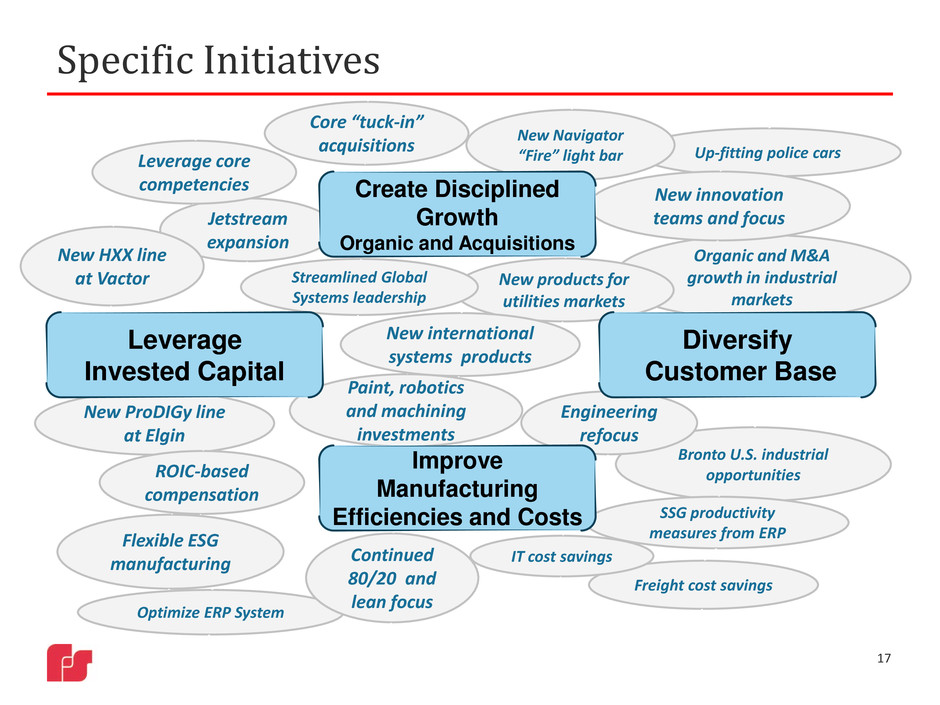
Organic and M&A growth in industrial markets New products for utilities markets Optimize ERP System Freight cost savings Jetstream expansion Bronto U.S. industrial opportunities Flexible ESG manufacturing Up-fitting police cars New Navigator “Fire” light bar Specific Initiatives 17 New innovation teams and focus New HXX line at Vactor New ProDIGy line at Elgin Leverage core competencies ROIC-based compensation Streamlined Global Systems leadership IT cost savings SSG productivity measures from ERP New international systems products Core “tuck-in” acquisitions Continued 80/20 and lean focus Paint, robotics and machining investments Engineering refocus Diversify Customer Base Leverage Invested Capital Improve Manufacturing Efficiencies and Costs Create Disciplined Growth Organic and Acquisitions

Consolidated Historical Financial Performance* 18 ($ in millions) 2012 2013 2014 Q1 2015 Net sales $ 803.2 $ 851.3 $ 918.5 $ 221.6 % Growth 16.6% 6.0% 7.9% Cost of sales 613.4 646.2 685.2 162.4 Gross profit $ 189.8 $ 205.1 $ 233.3 $ 59.2 % Margin 23.6% 24.1% 25.4% 26.7% Operating expenses 138.3 134.5 140.7 34.4 Operating income $ 51.5 $ 70.6 $ 92.6 $ 24.8 % Margin 6.4% 8.3% 10.1% 11.2% Interest expense 21.4 8.8 3.8 0.6 Debt settlement charges 3.5 8.7 - - Other expense, net 0.7 0.1 1.5 0.9 Pre-tax income $ 25.9 $ 53.0 $ 87.3 $ 23.3 * Consolidated financial results reflect only continuing operations of the Company.

EPS Trends and Outlook 19 Adjusted Earnings Per Share * * To facilitate comparisons to 2015, adjusted earnings for 2014 are $0.93 per share, which is computed after excluding the benefit from a release of valuation allowance against foreign deferred tax assets and a tax benefit associated with change in Spanish tax rate. GAAP earnings for 2014 were $0.99 per share. Adjusted earnings for 2013 were $0.67 per share, which is computed after excluding special tax items, the impacts of restructuring and debt settlement charges and applying a normalized income tax rate of 32%. A reconciliation of adjusted earnings per share is included in Appendix 1. Full Year Range $0.95- $1.02 0.19 0.35 0.67 0.93 0.23 0.00 0.10 0.20 0.30 0.40 0.50 0.60 0.70 0.80 0.90 1.00 1.10 YR 2011 YR 2012 YR 2013 YR 2014 YR 2015 $ per share Q1 2015 EPS

Capital Allocation Priorities • Strong cash flow and flexibility TTM Q1 2015 cash flow from operating activities of $82.6 M At 0.4 times adjusted EBITDA, debt is already low • Funding of internal growth opportunities Projects leverage existing businesses and generally require limited cash investment Innovation efforts target new and updated products Generally, already funded within operating results and cash flow • Acquisitions Targeting tuck-in opportunities which leverage core operations, are modest size (+/- $50 M), with returns greater than FSS cost of capital, and accretive within a year Would also consider transformational acquisitions • Quarterly dividend In the first quarter of 2015, we doubled our quarterly dividend to $0.06 per share • Share repurchase programs Spent $13.8 M to repurchase approximately 930,000 shares of our stock under authorized share repurchase programs The remaining aggregate authorization under these programs represents approximately 8% of our market capitalization 20
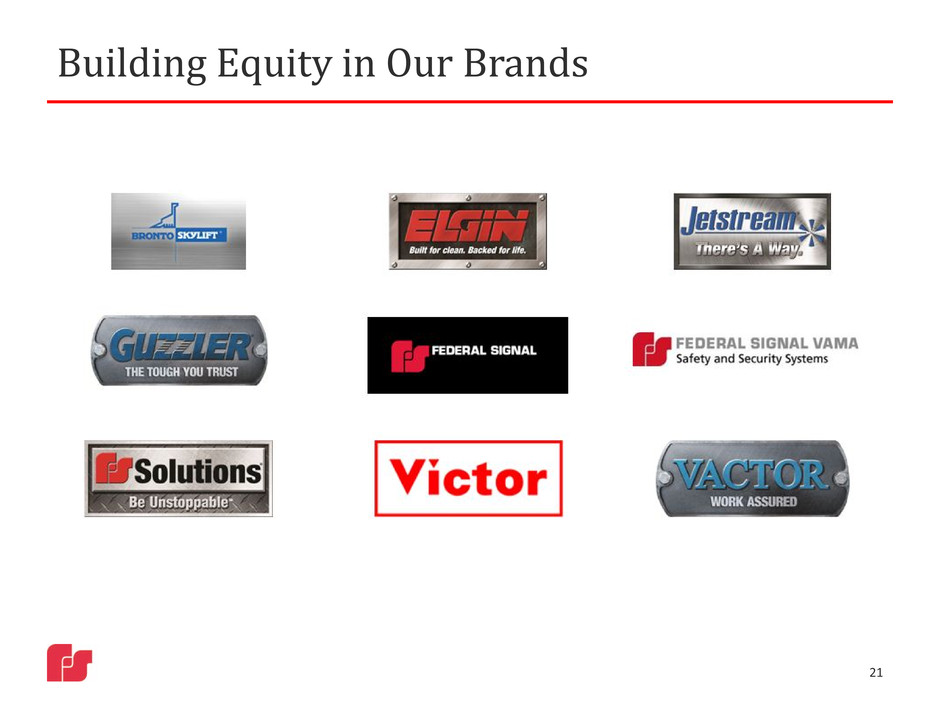
Building Equity in Our Brands 21

Appendix 1: Adjusted Earnings per Share * 22 * The adjusted financial measures presented above are unaudited and are not in accordance with U.S. generally accepted accounting principles (“GAAP”). The non-GAAP financial information presented herein should be considered supplemental to, and not a substitute for, or superior to, financial measures calculated in accordance with GAAP. The Company has provided this supplemental information to investors, analysts, and other interested parties to enable them to perform additional analyses of operating results, to illustrate the results of operations giving effect to the non-GAAP adjustments shown in the reconciliations below, and to provide an additional measure of performance which management considers in operating the business. ($ in millions, expect per share amounts) 2012 2013 2014 Q1 2015 Income from continuing operations 22.0$ 160.2$ 63.0$ 14.9$ Add (less): Income tax expense (benefit) 3.9 (107.2) 24.3 8.4 Income before income taxes 25.9 53.0 87.3 23.3 Add (less): Restructuring 1.4 0.7 - - Debt settlement charges 3.5 8.7 - - Adjusted income before income taxes 30.8 62.4 87.3 23.3 Adjusted income tax expense (1) (8.6) (20.1) (28.2) (8.4) Adjusted net income from continuing operations 22.2$ 42.3$ 59.1$ 14.9$ EPS from continuing operations (diluted) 0.35$ 2.53$ 0.99$ 0.23$ Adjusted EPS from continuing operations (diluted) 0.35$ 0.67$ 0.93$ 0.23$ (1) Adjusted income tax expense for f iscal years 2012-2013 w as computed by applying the Company's normalized effective tax rate of approximately 28% and 32% for 2012 and 2013, respectively. The normalized tax rate excludes the impacts of the valuation allow ance release and other special tax items in these periods. Adjusted income tax expense for 2014 w as recomputed after excluding the impact of a release of valuation allow ance against foreign deferred tax assets and a tax benefit associated w ith change in Spanish tax rate.

Appendix 2: Total Debt to Adjusted EBITDA 23 The Company uses the ratio of total debt to adjusted EBITDA as one measure of its long-term financial stability. The ratio of debt to adjusted EBITDA is a non-GAAP measure that represents total debt divided by the trailing 12-month total of income from continuing operations before interest expense, debt settlement charges, other expense, income tax benefit or expense and depreciation and amortization expense. The Company uses the ratio to calibrate the magnitude of its debt and its debt capacity against adjusted EBITDA, which is used as an operating performance measure. We believe that investors use a version of this ratio in a similar manner. In addition, financial institutions (including the Company’s lenders) use the ratio in connection with debt agreements to set pricing and covenant limitations. For these reasons, the Company believes that the ratio is a meaningful metric to investors in evaluating the Company’s long-term financial performance and stability. Other companies may use different methods to calculate total debt to EBITDA. The following table summarizes the Company’s ratio of total debt to adjusted EBITDA, and reconciles income from continuing operations to adjusted EBITDA as of and for the trailing twelve month periods ended March 31, 2015 and 2014: ($ in millions) 2015 2014 Total Debt 52.9$ 88.1$ Income from continuing operations 70.3 168.9 Add: Interest expense 3.4 5.3 Other expense, net 2.4 0.3 Income tax expense (benefit) 28.5 (103.2) Depreciation and amortization 15.2 14.4 Adjusted EBITDA 119.8$ 85.7$ Total debt to adjusted EBITDA ratio 0.4 1.0 ($ in millions) Q1 2015 Q4 2014 Q1 2014 Total Debt 52.9$ 50.2$ 88.1$ Less: Cash and cash equivalents (23.0) (30.4) (16.0) Net Debt 29.9$ 19.8$ 72.1$
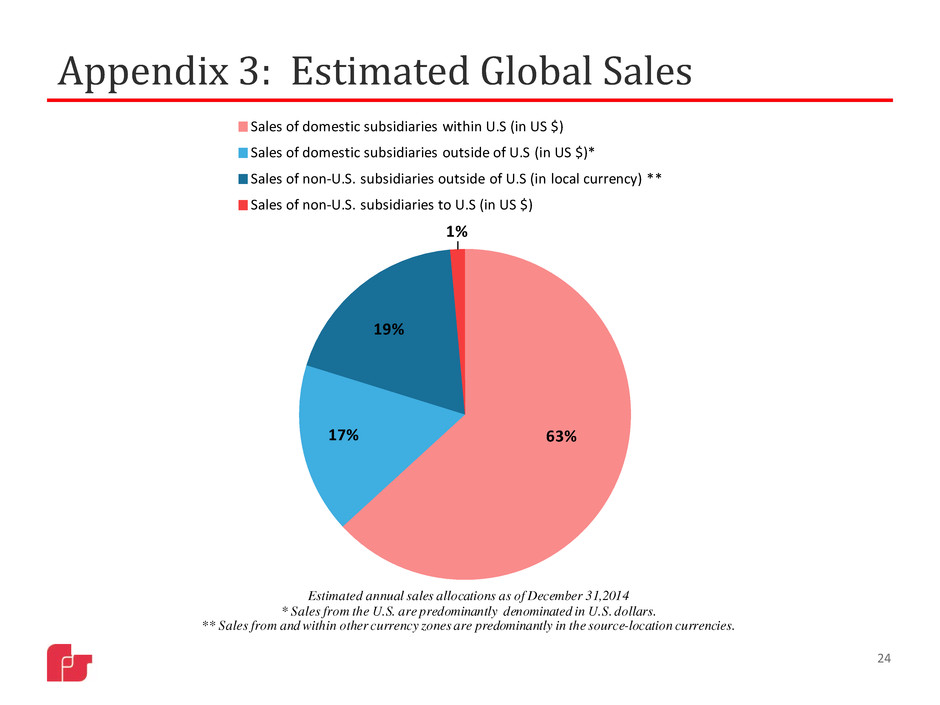
63%17% 19% 1% Sales of domestic subsidiaries within U.S (in US $) Sales of domestic subsidiaries outside of U.S (in US $)* Sales of non-U.S. subsidiaries outside of U.S (in local currency) ** Sales of non-U.S. subsidiaries to U.S (in US $) Estimated annual sales allocations as of December 31,2014 * Sales from the U.S. are predominantly denominated in U.S. dollars. ** Sales from and within other currency zones are predominantly in the source-location currencies. Appendix 3: Estimated Global Sales 24
